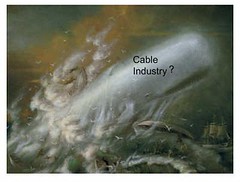Major speed enhancements are rumored to be coming soon from Comcast, which has been spending serious cash to upgrade its network to the DOCSIS 3.0 standard. Customers in many markets who now pay $42.95 a month for 6mbps/1mbps service will be upgraded to 12/2 — a doubling of both upstream and downstream speeds — with no corresponding price increase. This follows Comcast’s pattern of enhancing speeds without hiking prices. And the price point of the standard tier has remained unchanged in nominal terms for several years, so when you factor in inflation, it’s fair to say Comcast has actually been dropping prices.
It’s amazing to consider how broadband speeds have evolved in a relatively short perio d of time. Comcast’s highest tier was a mere 4mbps/384kbps just four years ago, when DSL speeds typically topped out at 3/768. For consumers who live in a competitive ISP market, DSL now offers 20/1, Fiber offers 30/5, and Cable will soon offer 22/5. All of these tiers are priced under $100 per month.
d of time. Comcast’s highest tier was a mere 4mbps/384kbps just four years ago, when DSL speeds typically topped out at 3/768. For consumers who live in a competitive ISP market, DSL now offers 20/1, Fiber offers 30/5, and Cable will soon offer 22/5. All of these tiers are priced under $100 per month.
Though we may not be amidst a “price war” among ISPs per se, as Mike Masnick recently argued, there is simply no denying that price per megabit is declining rapidly. This is all thanks to competition, of course, which has pushed providers to invest in newer technologies that allow for faster broadband connectivity.
Market skeptics will assuredly respond to my optimism by pointing out that so long as Comcast sticks with its 250GB monthly usage cap, consumers are really just getting the same service with shinier packaging. Yet that fact hardly means we should scoff at Comcast’s new performance tiers.
As I’ve discussed on several occasions, I churn through a lot of file transfers each month, so I’m all for Comcast raising its cap (or, alternatively, implementing reasonable overage fees). But even with Comcast’s fairly generous limits, who isn’t ecstatic about being able to download any file in half as much time as before? Caps will surely evolve over time as demand for 1080p content delivered over the Internet grows, but for now, speed is a bigger concern than usage for most consumers.



 The Technology Liberation Front is the tech policy blog dedicated to keeping politicians' hands off the 'net and everything else related to technology.
The Technology Liberation Front is the tech policy blog dedicated to keeping politicians' hands off the 'net and everything else related to technology.